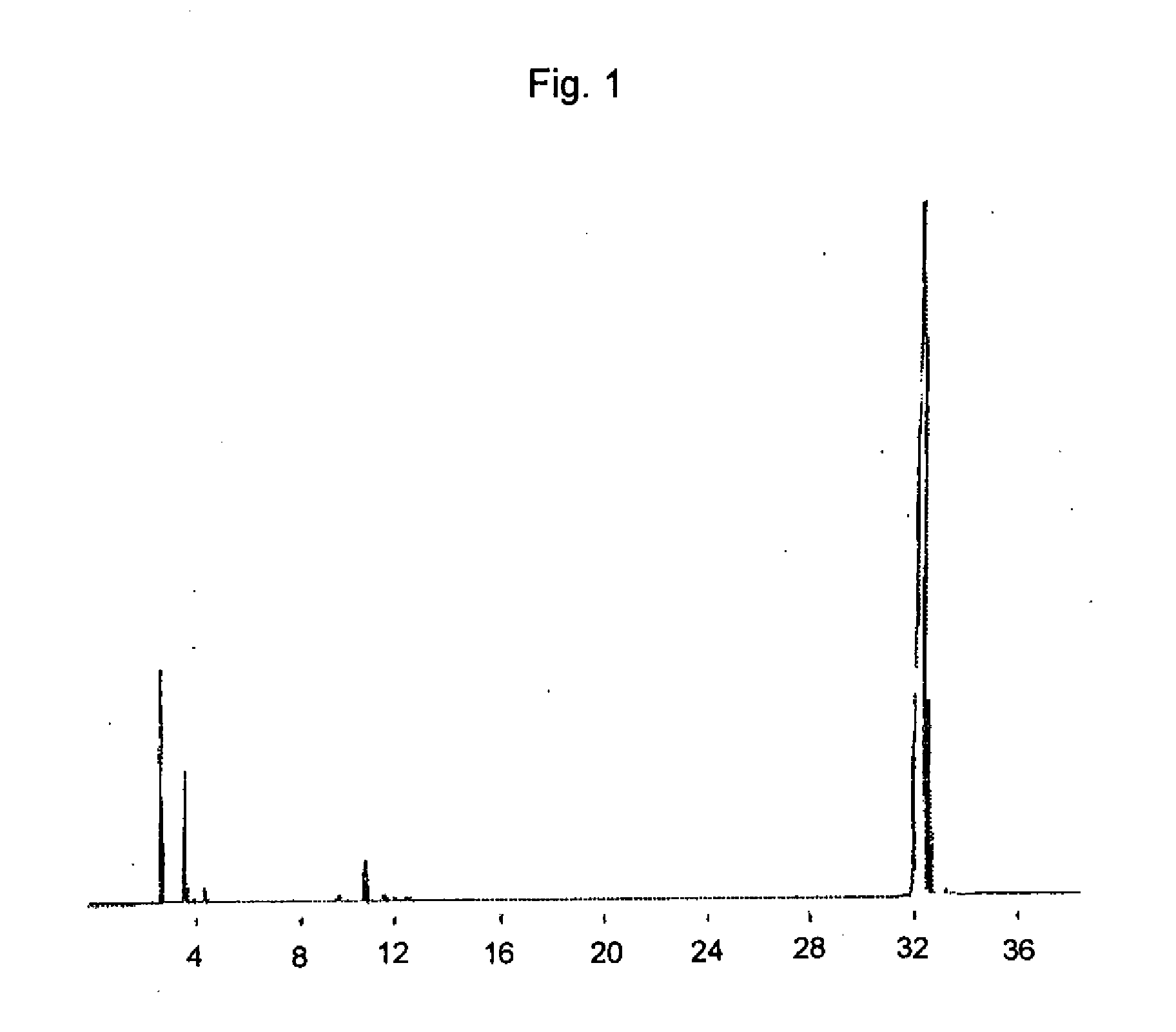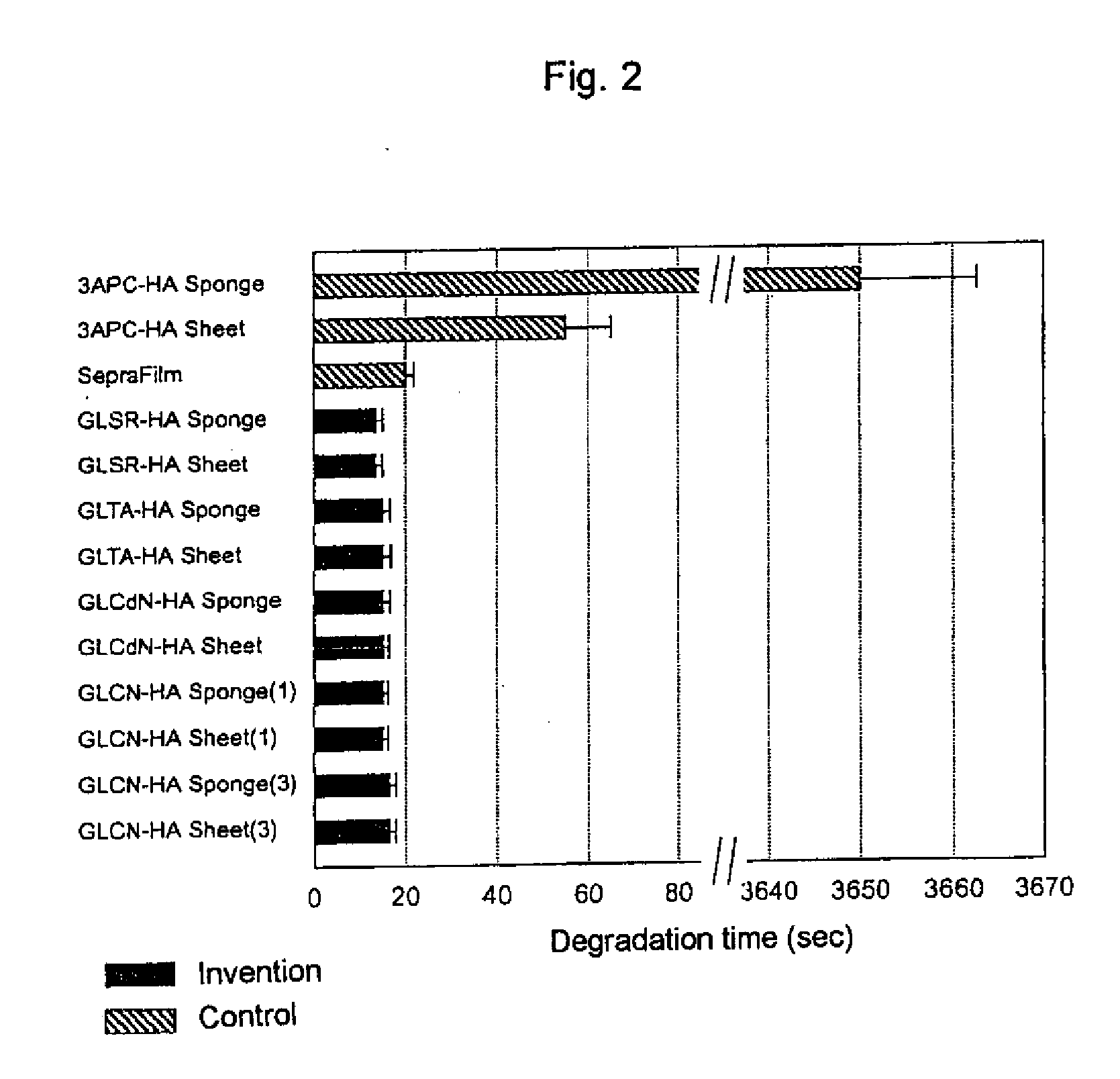Photoreactive polysaccharide, photocrosslinked polysaccharide product and method of making same and medical materials made from the crosslinked polysaccharide
a crosslinked polysaccharide and photoreactive polysaccharide technology, applied in the field of photoreactive polysaccharide, a photocrosslinked polysaccharide product, can solve the problems of difficult removal of unreacted crosslinking agent from the crosslinked-gel after completion of the reaction, crosslinking agent incorporation into the inner area, and difficult removal of unreacted crosslinking agen
- Summary
- Abstract
- Description
- Claims
- Application Information
AI Technical Summary
Benefits of technology
Problems solved by technology
Method used
Image
Examples
reference example 1
[0093] (Synthesis of Glycidyl Ester of Photoreactive Compound.)
[0094] 1 . Synthesis of Glycidyl Cinnamate.
[0095] To 7.5 g of trans-cinnamic acid (manufactured by Wako Pure Chemical) were added 3 g of tetraethylammonium bromide (manufactured by Wako Pure Chemical) and 100 ml of epichlorohydrin (manufactured by Wako Pure Chemical), the mixture was heated to reflux at 110° C. for 3 hours, 50 ml of distilled water was added thereto, an organic layer was separated, concentrated in vacuo at 80° C. and distilled under reduced pressure of 6 mmHg and the fraction of 130 to 160° C. was recovered to give 12 g of glycidyl cinnamate. An epoxy equivalent of this glycidyl cinnamate was 240.3.
[0096] The resulting glycidyl cinnamate was analyzed by gas chromatography. In the gas chromatography, GC-17A (manufactured by Shimadzu) was used and the measurement was carried out using a column DB-5 (membrane thickness: 0.5 μtm; inner diameter: 0.25 mm; length: 30 m) at the column temperature of 100° C. ...
example 1
[0103] (Manufacture of Hyaluronic Acid into which Glycidyl Cinnamate is Introduced (Hereinafter Sometimes Referred to as GLCN-HA) and a Crosslinked Product Thereof).
[0104] 1-(1). Synthesis of GLCN-HA (Reverse Precipitation Method)
[0105] To 100 ml of a 1 wt % aqueous solution of hyaluronic acid (weight-average molecular weight: 800,000) were added 50 ml of water for injection and 75 ml of 1,4-dioxane, and 3 ml of glycidyl cinnamate (epoxy equivalent: 240.3) was added thereto, followed by stirring for 24 hours in a constant-temperature vessel of 50° C.
[0106] Sodium Chloride (1 g) was added to the above described solution, followed by stirring, and the mixture was poured into 800 ml of ethanol to give a cotton-like precipitate. The precipitate was well washed with ethanol and dried to give 1.1 g of GLCN-HA. The degree of substitution of glycidyl cinnamate was 2.9%.
[0107] 1-(2). Synthesis of GLCN-HA (Normal Precipitation Method).
example 2
[0125] (Preparation of Hyaluronic Acid into Which Glycidyl Thiopheneacrylate is Introduced (Hereinafter Referred to as GLTA-HA) and a Crosslinked Product Thereof Synthesis of Hyaluronic Acid into Which Glycidyl Thiopheneacrylate is Introduced (GLTA-HA)).
[0126] To 100 ml of a 1 wt % aqueous solution of hyaluronic acid (weight-average molecular weight: 800,000) were added 50 ml of water for injection and 75 ml of 1,4-dioxane, and 3 ml of glycidyl thiopheneacrylate (epoxy equivalent: 596.8) was added thereto, followed by stirring for 24 hours in a constant-temperature vessel of 50° C.
[0127] Sodium chloride (1 g) was added to the resulting solution, followed by stirring, and the mixture was poured into 800 ml of ethanol to give a cotton-like precipitate. The resulting precipitate was well washed with ethanol and dried to give 1.1 g of GLTA-HA. The measured degree of substitution of glycidyl thiopheneacrylate was 1.4%.
Preparation of Photocrosslinked-Hyaluronic Acid Gel.
[0128] A gel-...
PUM
| Property | Measurement | Unit |
|---|---|---|
| wavelength | aaaaa | aaaaa |
| pore size | aaaaa | aaaaa |
| diameter | aaaaa | aaaaa |
Abstract
Description
Claims
Application Information
 Login to View More
Login to View More - R&D
- Intellectual Property
- Life Sciences
- Materials
- Tech Scout
- Unparalleled Data Quality
- Higher Quality Content
- 60% Fewer Hallucinations
Browse by: Latest US Patents, China's latest patents, Technical Efficacy Thesaurus, Application Domain, Technology Topic, Popular Technical Reports.
© 2025 PatSnap. All rights reserved.Legal|Privacy policy|Modern Slavery Act Transparency Statement|Sitemap|About US| Contact US: help@patsnap.com



